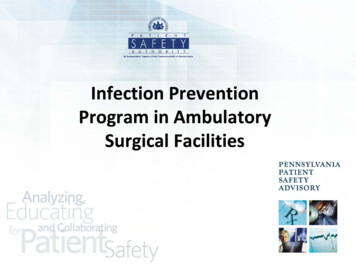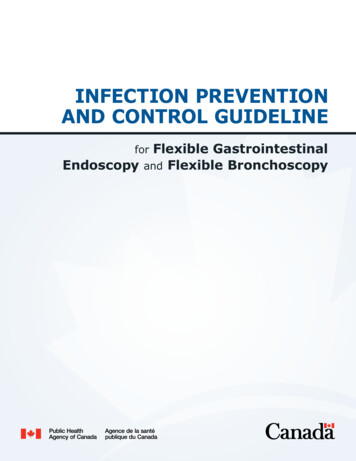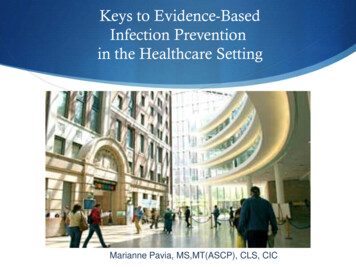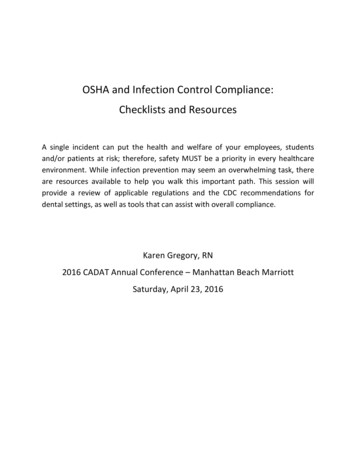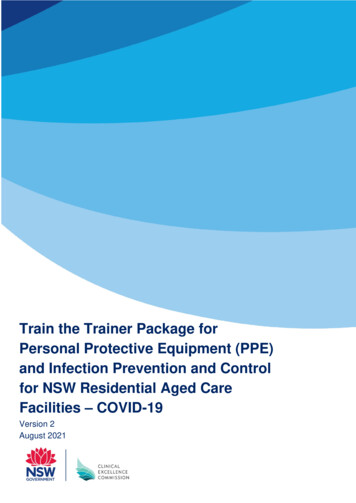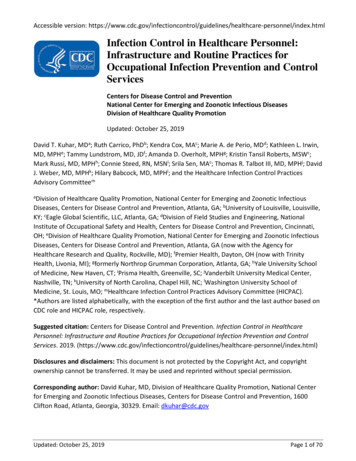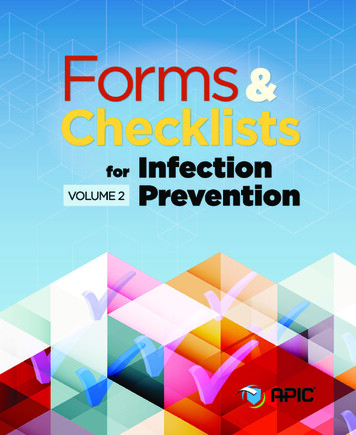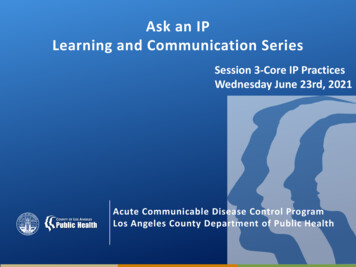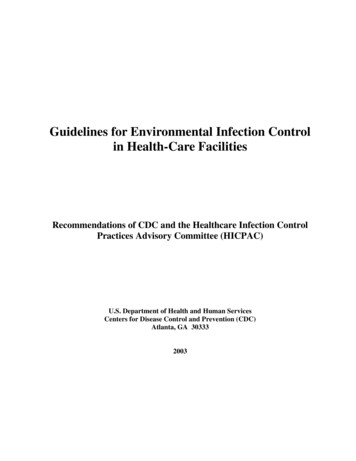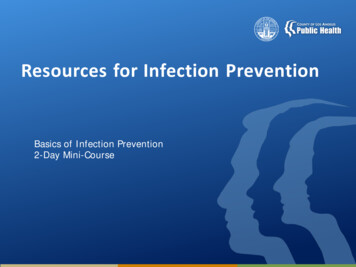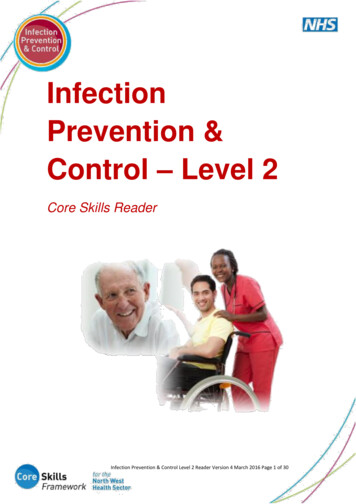
Transcription
InfectionPrevention &Control – Level 2Core Skills ReaderInfection Prevention & Control Level 2 Reader Version 4 March 2016 Page 1 of 30
Introduction to the Core SkillsThe Core Skills standardises the training for 10 subjects commonly delivered aspart of statutory and mandatory training requirements for health and social careorganisations.For each subject a set of learning outcomes has been agreed nationally and is setout in the UK Core Skills Training Framework (a copy of the framework isavailable on the Skills for Health website: www.skillsforhealth.org.uk/).The learning outcomes specify what needs to be covered in the training for eachCore Skills subject. This ensures a quality standard is set and provides clearguidance for organisations to deliver against these requirements as well asrecognise the equivalent training delivered externally. This allows for Core Skillstraining to be portable between organisations and prevents the needless wasteand duplication of statutory and mandatory training where it is not required.To aid organisations in the delivery of the Core Skills subjects, these educationresources have been developed to be aligned to the learning outcomes in the UKtraining framework. Organisations have the flexibility to deliver these resources in avariety of formats as well as adapting them to add localised content alongside theCore Skills Materials.If you require any further information about the Core Skills, in the first instanceplease contact the Learning and Development Lead in your organisation.In the North West, the implementation and management of the Core Skills isoverseen by the North West Core Skills Programme on behalf of Health EducationNorth West. The programme can be contacted on: CoreSkills.Programme@nhs.netIntroduction to Infection Prevention & ControlThis reader covers the learning outcomes for Core Skills Infection Prevention &Control – Level 2. It can be used either as a standalone document or as supportingmaterial alongside the Infection Prevention & Control presentation or e-Learningpackage (the relevant slide numbers and eLearning pages are given with each subheading). Whichever way the reader is used, it is recommended that the Infection,Infection Prevention & Control Level 2 Reader Dec-14 Page 2 of 30
Prevention & Control Assessment is completed afterwards to allow the learner todemonstrate they have retained the knowledge and learning required to supportbest practice.This resource has been designed to cover and addresses the key principlesin Infection, Prevention & Control.It is anticipated that it will take you approximately 20-30 mins to complete thisreader. Current national guidelines recommend that training for Infection Prevention& Control – Level 2 is repeated a minimum of every three years.Infection Prevention & Control Level 2 Reader Dec-14 Page 3 of 30
What you will learn in this session(eLearning Page 2)The objectives covered by this reader are listed below and aligned to the LearningOutcomes for Infection, Prevention & Control – Level 2 in the Core Skills TrainingFramework.a) Be able to describe the healthcare organisation’s and their own responsibilities interms of current infection prevention and control legislationb) know how to obtain information about infection prevention and control within theorganisationc) understand what is meant by the term healthcare associated infectionsd) understand the chain of infection and how this informs infection preventionand control practicee) demonstrate an understanding of the routes of transmission of micro-organismsf) understand individual roles and responsibilities for the three levelsof decontaminationg) use single use items appropriatelyh) be able to conduct a risk assessment in respect of ensuring infection preventionand controli) explain different alert organisms and conditions that pose an infection riskj) describe how to safely manage patients with specific alert organismsInfection Prevention & Control Level 2 Reader Dec-14 Page 4 of 30
Health Care Associated Infection (HCAI)(eLearning Page 3)HCAIs are infections that are acquired as a result of healthcare interventionsand can occur in otherwise healthy individuals especially if invasive proceduresare used. HCAIs are caused by a wide range of micro-organisms. HCAIs canexacerbate existing or underlying conditions, delay recovery and adversely affectquality of life. There are a number of factors that can increase the risk of acquiringan infection, but high standards of infection control practice will minimise the risk ofoccurrence.There are at least 300,000 patients a year in England that acquire a HCAI asa result of care within the NHS. These lead to more than 9000 deaths a year.(NICE 2012)The prevalence of healthcare- associated infections (HCAI) was 6.4% in2011 compared to 8.2% in 2006 (HPA 2011).Top 5 Infections(eLearning Page 4)Infection Prevention & Control Level 2 Reader Dec-14 Page 5 of 30
Vulnerable to infections(eLearning Page 5)Some people are more susceptible to healthcare associated infections, thiscould be due to: low immunity, recovering from illness, being under nourished, having an underlying disease, if they are very young/old.Individual responsibilities(eLearning Page 6)It is everyone’s responsibility to maintain consistent infection preventionand control practice and a safe working environment.Three obligations: Contractual Professional LegalCompliance with Health and Social Care Act (2008)Local procedures and policyImportant points of personal hygiene Wear a clean uniform every day. Look presentable and professional. Staff withlong hair should have it tied back and off thecollar. Don't wear jewellery, rings with stones, acrylicnails, wristbands and watches. Your arms should be bare below the elbow. Infection Prevention & Control Level 2 Reader Dec-14 Page 6 of 30
Methods of spread(eLearning Page 9)Method of ionIndirect/FomitesExampleChest Infections, Colds and fluFlies, rats, mice and cockroachesNeedle stick injurySkin to skin contactFood poisoning, salmonella, norovirus and E Coli 0157Equipment, door handles and furnitureThree elements in the chain ofinfection (eLearning Page 12)The chain of infection consists of three main elements. Micro-organism Means of transport Host Example of the chain ofinfection (eLearning Page 13)Causative Agent - Clostridium difficile (C.difficile)Infection Reservoir - Up to 5% of the general population has C.difficile in theirintestines. Not all people, if any, are symptomatic. However, for example,inappropriate antibiotics, proton pump inhibitors, increasing morbidity could lead todeveloping C.difficile disease.A piece of equipment could also be a reservoir, for example, a commodecontaminated with C.difficile that is not decontaminated between patient usePortal of Exit - Profuse watery diarrhoeaModes of Transmission - Diarrhoea increases the risk of spread of the organism.C.difficile can be spread by hands, equipment, clothes, PPE and thecontaminated environmentPortal of Entry - C.difficile enters the body via the oral route i.e. it is ingested. Thehands of patients may become indirectly contaminated from the contaminated localenvironment, equipment or hands of health care staff. The patientInfection Prevention & Control Level 2 Reader Dec-14 Page 7 of 30
consequently may not clean their hands prior to eating or may touch their mouthduring the course of the day. This is called the faecal oral route of transmissionSusceptible host - Some people are more susceptible, this could be due to: lowimmunity, recovering from illness, being under nourished, having an underlyingdisease, or if they are very young/old.Breaking the chain ofinfection (eLearning Page 15)In some instances the risk of infection may be prevented or reduced by the useof vaccination e.g. TB, tetanus, polio, diphtheria, or by the use of prophylacticantibiotics e.g. PreOp. Generally the chain of infection can be broken by theeffective use of standard precautions (listed below) which breaks the ‘route oftransmission’ link. Hand hygiene.Aseptic techniques.Cleaning equipment effectively and appropriately.Environmental cleaning.Wearing personal protective equipment (PPE) properly.Segregating laundry appropriately.Isolating or barrier nursing of the patient.Appropriate waste disposal, including sharps.Antimicrobial-resistant infections(eLearning Page 16)Carbapenems are powerful broad-spectrum antibiotics that are often the last lineof effective treatment for patients with multidrug-resistant infections, includingthose caused by ESBL-producing bacteria. Cases of carbapenem resistance in E.coli and Klebsiella in the UK started to increase during 2008 and 2009.(Society for General Microbiology 2011)For more information on antibiotic use please refer to antibiotic policies or guidancein your organisation.Infection Prevention & Control Level 2 Reader Dec-14 Page 8 of 30
Antimicrobial-resistant infections(eLearning Page 17)Chief Medical Officer annual report: volume 2 (March 2013) The report highlightsthat, while a new infectious disease has been discovered nearly every year overthe past 30 years, there have been very few new antibiotics developed leaving ourarmory nearly empty as diseases evolve and become resistant to existing drugs.“Antimicrobial resistance (AMR) is resistance of a microorganism to an antimicrobialmedicine to which it was previously sensitive. Resistant organisms (they includebacteria and viruses) are able to withstand attack by antimicrobial medicines, suchas antibiotics and antivirals, so that standard treatments become ineffective andinfections are prolonged, with longer periods of infectivity and may spread to others.Inappropriate and irrational use of antimicrobial medicines provides favourableconditions for resistant microorganisms to emerge, spread and persist.(WHO 2012).Ward closures(eLearning Page 18)Within the NHS, high priority is given to preventing HCAIs. Achieving success isan immense task but a very important one. A National Audit Office survey of NHSacute trusts found that there has been an increase in the number of infectionoutbreaks leading to ward closures.Outbreaks of hospital infection vary greatly in extent and severity, ranging froma few cases of diarrhoea and vomiting, to a larger outbreak of food poisoninginvolving hundreds of people.Effective standard precautions by all staff will help prevent the spread ofInfections and help prevent wards being closed due to an outbreak.Effective surveillance, assessment and isolation of symptomatic patients andstandard precautions by all staff will help prevent the spread of infections. Thisincludes careful hand hygiene with soap and water; use of PPE; adequatecleaning/disinfection; careful handling of contaminated laundry and correct wastedisposal.Infection Prevention & Control Level 2 Reader Dec-14 Page 9 of 30
Standard precautions(eLearning Page 19)Standard precautions - practices to reduce the spread of infection.The standard precautions were formerly known as universal precautions. Theyare infection control measures which should be applied at all times by all stafffor all patients/clients regardless of the diagnosis or presumed infection status.1. Hand hygiene2. Protective clothing/equipment3. Environmental cleaning4. Management of clinical waste5. Prevention of sharps injuries6. Decontamination of equipment7. Careful handling of linenHand hygiene(eLearning Page 20)Hands are one of the most common means of transmitting micro-organisms andspreading infections. However simple routines can be used to decontaminate themand staff should be aware of how and when to use them.You should clean your hands: before and after direct patient care after dealing with contaminated equipment after dealing with waste/bodily fluids before handling food/beverages/drugs after using the toilet Did you know that soiled fingers can consecutively contaminate up to 7 surfaces?Infection Prevention & Control Level 2 Reader Dec-14 Page 10 of 30
5 moments for hand hygiene at the point ofcare (eLearning Page 23)Moment 1 – Decontaminate handsbefore touching each patientMoment 2 – Decontaminate yourhands before performing aseptic tasksMoment 3 – Clean your hands straightaway6 after possible exposure tobodily fluidsMoment 4 – Decontaminate handsafter touching each patient andtheir surroundingsMoment 5 - Decontaminate hands after touching a patient’s surroundings even ifpatient has not been touchedHand hygiene 3(eLearning Page 24)As you have seen you can use water and liquid soap to decontaminate yourhands. Another method is alcohol hand rub which can be used providing yourhands are visibly and socially clean.Alcohol rub is:- Quick and effective on most organisms- Available at every bedside and ward entrance- Used throughout the Trust- Not effective for Clostridium difficile infection, norovirus or otherinfective diarrhoeas.Infection Prevention & Control Level 2 Reader Dec-14 Page 11 of 30
Personal Protective Equipment (PPE)(eLearning Page 27)When you are performing a clinical procedure PPE, which includes gloves andaprons and if required, face masks and eye protection, should be used to preventmicro- organisms from coming into contact with you or with your clothing. Sincethere is a high risk of the PPE becoming contaminated it is essential to remove it assoon as you have completed the procedure and then to thoroughly clean yourhands. Although the NHS is required to provide suitable equipment it is theresponsibility of the individual concerned to use it correctly and appropriately.Gloves(eLearning Page 28)Gloves must be worn: when dealing with blood / body fluids when dealing with patients isolated with diarrhoea when dealing with non intact skin / mucous membranes when dealing with hazardous chemicals / medicines as part of Aseptic Non Touch Technique (ANTT) once, because they are for single use and should be changed foreach procedure.Take gloves off at point of use and clean handsDon’t carry gloves in your pocketDo not use alcohol hand rub on glovesGloves must be removed as soon as the clinical activity is completed. Touching thepatient or the immediate patient environment can contaminate the gloves whichcould then lead to cross-contamination of, for example – door knobs, lightswitches, telephones, computer keyboards, stacker drawers etc.Infection Prevention & Control Level 2 Reader Dec-14 Page 12 of 30
Aprons(eLearning Page 32)Remember that it is much easier to change a soiled apron than a dirty uniform.Aprons are single patient use.Change your apron between patients/procedures:- when you anticipate close patient contact- when dealing with blood, bodily fluids, excretions and secretions- to protect you from being contaminated with micro-organisms- to protect the patient at risk- protecting yourself from substances that are hazardous to your health(Control Of Substances Hazardous to Health - COSHH)- during asepsis.Aprons(eLearning Page 33)Mask/Eye ProtectionFacemasks and eye protection must be worn where there is a risk of blood / bodyfluids splashing into face and eyes.Cleaning(eLearning Page 34)We are all responsible for ensuring that we maintain good personal and handhygiene, and that our working environment and any equipment used is kept cleanand safe. This includes keeping clinical areas tidy, as the presence ofunnecessary clutter interferes with the cleaning process. Even if surfaces havebeen cleaned thoroughly they may still become contaminated with dust and dirt.Dust contains dead skin cells and fibres where the micro-organisms can survive.Level 1 clean – daily clean around patient area/equipment with soap and water forpatients identified with, for example, MRSA, ESBL or AmpC (beta-lactamases).Level 2 clean – daily disinfection with 1000ppm Chlorclean for patients identifiedwith, for example, infective diarrhoea (C.difficile, Norovirus), VRE or KPC.Terminal clean – on patient discharge all equipment and bed area has a level 2clean and curtain change.Infection Prevention & Control Level 2 Reader Dec-14 Page 13 of 30
Body fluid spillages(eLearning Page 35)Body fluid spillages must be dealt with by the person who finds the spillage.Following a risk assessment and wearing appropriate PPE : Soak up excess fluid using disposable towels and dispose directlyinto clinical waste bag. Wipe over the area with DETERGENT AND WATER.IF, following a risk assessment, the body fluid spillage is deemed infective (e.g.infective diarrhoea/vomit) use 1,000 parts per million (p.p.m) solution ofChlorclean (1 tablet in 1 litre of cold water).Blood requires one of two clean-up processes, which must be done by theperson who finds the spillage. Wearing appropriate PPE:1. Soak up excess fluid using disposable towels and dispose directly intoclinical waste bag.2. Wipe over the area with 10,000 parts per million (p.p.m) solution of ChlorCleanor Virusolve Plus wipes.OR1. Cover the spillage with HazTab granules.2. Leave for 2 minutes.3. Scoop up the debris with disposable towels and place directly into clinicalwaste bag.4. Wash the area with detergent and warm water.Infection Prevention & Control Level 2 Reader Dec-14 Page 14 of 30
Splashes(eLearning Page 36)Exposure to bloodborne pathogens can be through incidents such as a sharpsinjury, splash of blood to the eyes and mouth or a wound on your skin.To reduce the risk you must;- Handle and dispose of sharps safely;- Wear face (including eye) protection if there is a risk of splashing;- Cover wounds with a waterproof plaster;- Wear personal protective equipment (PPE).If you get blood or bodily fluids in your mouth, eyes or a wound on the skin: Thoroughly rinse with runningwater Inform your manager Ring the occupational health department within working hours or A&E outof hours.Linen(eLearning Page 37)Used Linen- Wear plastic apron.- Handle carefully.- Place immediately into white plastic laundry sack.- Store in a designated area.Soiled/Infected Linen- Wear plastic apron/gloves- Handle carefully- Place in red water soluble bag and then into the white plastic laundry sack.- Store in a designed areaDecontamination of equipment(eLearning Page 38)EquipmentEquipment needs to be cleaned appropriately after every patient use.Equipment needs to be decontaminated if going for maintenance and adecontamination certificate completed.Infection Prevention & Control Level 2 Reader Dec-14 Page 15 of 30
There are 3 levels of decontamination:- Cleaning - soap and water / detergent wipes e.g. BP cuff, Glucometer- Disinfection - Alcohol wipe / chlorine releasing agent e.g. ANTT tray (70%Isopropyl alcohol (IPA) & 2% Chlorhexidine wipe), equipment following use by apatient suspected of or identified with infectious diarrhoea (Chlorclean)- Sterilization - Autoclave (e.g. surgical instruments, laryngoscope blades – ensuresafe/approved transfer/storage of instruments for sterilization)Cleaning ALWAYS precedes the disinfection and sterilization processesAll staff must be aware of their individual roles and responsibilities relating todecontamination. See your local decontamination policy or guidelines for furtherinformation.Safe waste disposal(eLearning Page 40)Waste products contaminated with blood or other bodily fluids are called “Infectious/ potentially infectious clinical waste” and should be disposed of in a way that avoidspotential harm to staff, patients or visitors.All clinical staff are responsible for the safe and correct disposal of sharps. Tofacilitate this, small sharps bins should be located at the point of use, to ensurethat used sharps can be disposed of immediately.You must NEVER overfill a sharps bin and NEVER try to re-sheath a needle.Bloodborne infections(eLearning Page 41)Exposure to bloodborne pathogens can be through incidents such as a sharpsinjury, splash of blood to the eyes and mouth or a wound on your skin. To reducethe risk you must:- handle and dispose of sharps safely;- wear face (including eye) protection if there is a risk of splashing;- wear Personal Protective Equipment (PPE);- cover wounds with a waterproof plaster.Infection Prevention & Control Level 2 Reader Dec-14 Page 16 of 30
Accidental Inoculation(eLearning Page 42)In the event of a sharps injury-Encourage the wound to bleed.Wash liberally with soap and running water.Cover the wound with a waterproof dressing.Report to your supervisor.Contact occupational health during open hours or A&E out of hours.Follow your organisation’s incident report procedure.Waste Segregation(eLearning Page 43)Aseptic Non Touch Technique (ANTT)(eLearning Page 44)Safe aseptic practice is paramount for protecting our patients duringinvasive clinical procedures e.g.IV TherapyRemoval of cannulaWound CareSterile samplingUrinary CatheterisationChest drain insertionCannulationLumbar PunctureAny invasive clinical procedureInfection Prevention & Control Level 2 Reader Dec-14 Page 17 of 30
Main principles of ANTT1. Risk Assessment for:Standard ANTT – General Aseptic Field (Promotes Asepsis)Surgical ANTT – Critical Aseptic Field (Ensures Asepsis)2. Glove selection – sterile or non sterile3. Key Part/Key site protection4. Appropriate PPE5. Effective decontamination of equipment and skin6. Safe disposal of clinical waste and sharpsANTT(eLearning Page 45)Standard ANTTAn aseptic field that promotes asepsis during procedures by providing basicprotection from the care environment, because key-parts will be easily protected bycaps and covers, non sterile gloves and a non touch technique. Examples include:venepuncture, cannulation, blood culture collection.Surgical ANTTCritical aseptic field that requires critical management to ensure asepsis i.e. onlysterilized equipment may come into contact with it. Sterile gloves must always beused (high risk of key part contact). Examples include: urinary catheterisation,wound care, lumbar puncture, chest drain insertion.There are 3 main stages in the ANTT process:Stage 1 - Preparation zoneStage 2 - Patient zoneStage 3 - Decontamination zoneInfection Prevention & Control Level 2 Reader Dec-14 Page 18 of 30
Stage 1 - Preperation zone(eLearning Page 46)Before commencing with preparation, ask yourself - Can the procedure beundertaken without the risk of touching (either directly or indirectly) key parts?Yes – Non sterile gloves must be wornNo – Sterile gloves must be wornYou need to take into account your own experience and competence withcertain procedures.1) Clean hands using soap & water or alcohol hand rub using 7stage technique2) Decontaminate tray or trolley with 70% Isopropyl alcohol (IPA) & 2%Chlorhexidine wipe, and allow to dry for 30 seconds (soap & water must beused first if visibly dirty).Stage 1 - Preperation zone(eLearning Page 47)3) Gather equipment whilst the tray is drying – hands will becomecontaminated whilst gathering equipment from common touch pointsi.e. cupboard door handles, stacking systems etc.4) Clean hands using soap & water or alcohol hand rub using 7stage technique.5) Apply appropriate PPE for preparation stage, gloves will be required forDrug Preparation, but not for all procedures.6) Critical stepPrepare equipment protecting key parts using a non touch technique7) Where gloves have been used for preparation (i.e. in IV therapy), removecontaminated gloves, clean hands with soap & water or alcohol hand rub andproceed directly to patient.Infection Prevention & Control Level 2 Reader Dec-14 Page 19 of 30
Stage 2 - Patient zone(eLearning Page 48)8) Before you touch the patient - Clean hands using soap & water or alcoholhand rub using 7 stage technique.9) Apply sterile or non sterile gloves (dependant upon procedure andrisk assessment) and any other appropriate PPE.10) Critical stepDecontaminate key parts/sites with 70% IPA and 2% chlorhexidine andallow to dry (30 secs).NB In wound care or urinary catheterisation use recommended product forcleaning.11) Critical stepPerform procedure using non touch technique protecting key parts at alltimes.12) Dispose of any sharps immediately into sharps bin.Stage 3 - Decontamination zone(eLearning Page 49)13) Remove gloves & apron immediately following procedure and dispose ofall equipment in nearest clinical waste bin.14) Clean hands using soap & water using 7 stage technique.15) Clean tray/trolley with detergent wipe or soap & water and return tostorage area.16) Clean hands using soap & water using 7 stagetechnique. 17) Complete any relevant documentation.For further information contact your ANTT lead.Responsibilities(eLearning Page 50)All healthcare organisations have the responsibility for ensuring effectivesystems are in place for infection prevention and control.In order to be successful, local procedures must be supported by ALL membersof staff.Infection Prevention & Control Level 2 Reader Dec-14 Page 20 of 30
Staff responsibilities(eLearning Page 51)The responsibilities of an Infection Prevention and Control Team are to: develop and review policies and procedures relating to the preventionand control of infection distribute policies to relevant areas and initiate their implementationby means of support, advice and education ensure that compliance with Infection Control policies are monitored byeither the Infection Control Team, Divisional Leads, designated Managersas appropriate formulate, implement and evaluate an Infection Control programme on anannual basis provide an ongoing training programme encompassing all healthcareworkers within the organisation provide specialist advice to key committees, groups, departments orindividual staff members in relation to Infection Control practice provide advice relating to Infection Control measures when caringfor patients with known or suspected infectious conditions advise and support patients and/or relatives in relation to infectiousconditions.Staff responsibilities continued(eLearning Page 52)The responsibilities of an NHS Infection Prevention and Control Team areto: review practice through Infection Control audits and recommendimprovements based on current guidance; research; evidence andbest practice. carry out alert organism surveillance, liaising with medical andnursing staff as appropriate. identify, control and advise on the management of outbreaks of infectionwithin the Trust. inform the local Health Protection Agency (HPU) of any significantepisodes of infection occurring. monitor and support incident reporting in relation to Infection controlissues/incidents and ensure appropriate risk assessments are completed.Infection Prevention & Control Level 2 Reader Dec-14 Page 21 of 30
Ensure any trends identified as a result of incident analysis are integratedinto work plans, policies and teaching programmes. ensure liaison with the Occupational Health Department with regardto staff health and transmission of infectious disease. demonstration of compliance with key external standards (i.e. NHSLA;Standards for Better Health, Care Quality Commission, Health Act2006, NHS North West (NHSNW) Provider Assurance framework),Staff responsibilities continued(eLearning Page 53)Divisional Leads:are responsible for ensuring the implementation of Infection prevention and controlpolicies and procedures through their clinical directorate structure. They are alsoresponsible for ensuring adequate allocation of funds to facilitate remedial action,following feedback from risk assessments or audits.Line Managers:are responsible for ensuring the implementation of advice, policies andprocedures within their department and for ensuring that their staff attendmandatory Infection control training sessions.All staff responsibilities(eLearning Page 54)All staff will be personally accountable for their action and responsible forensuring that they comply with Infection Control policies of their place of work.Staff must understand their legal duty to take reasonable care of their health,safety and security and that of other persons who may be affected by their actionsand for reporting untoward incidents and areas of concern.Any breach in Infection Control Policies or Practice will place staff, patients andvisitors at risk and subsequently the completion of a clinical incident form will berequired.All staff are obligated professionally, contractually and legally to adhere topolicies of their place of work that will help to prevent and control infections(Health and Social Care Act, DoH, 2008)Infection Prevention & Control Level 2 Reader Dec-14 Page 22 of 30
What to do when ill(eLearning Page 55)Infectious illnessYour local Occupational Health Department offer a range of services, includingimmunisations and advice on health matters. Their staff can advise you aboutfitness to work if you are suffering from infections such as coughs, colds, flu,diarrhoea or vomiting.Although it is widely believed that flu is very like the common cold this is not thecase. Flu has symptoms which differ from those of a cold, including a hightemperature, headache, shivery feelings, lack of energy and aching limbs.Diarrhoea and/or vomitingSeek medical advice. You must refrain from returning to work until you havebeen symptom free for 48 hours.Skin conditionsYou should ask the Occupational Health Department for advice if you suffer fromskin conditions such as psoriasis or eczema, especially if this is on your hands. Toreduce the risk of infection it is important to use the moisturisers avoid handsbecoming dry and cracked.MRSA(eLearning Page 57)MRSA stands for Meticillin-Resistant Staphylococcus aureusMRSA are Staphylococcus aureus bacteria that have become resistant tocertain antibiotics.People may be colonized or infected with S.aureus. Colonization means that the S.aureus is present in or on the body but isnot causing illness. Infection means that the S.aureus is present and is causing illness.How is MRSA spread?- MRSA is transmitted primarily by contact with a person who has aninfection or
Isolating or barrier nursing of the patient. Appropriate waste disposal, including sharps. Antimicrobial-resistant infections (eLearning Page 16) Carbapenems are powerful broad-spectrum antibiotics that are often the last line of effective treatment for patients with multidrug-resistant infections, including

